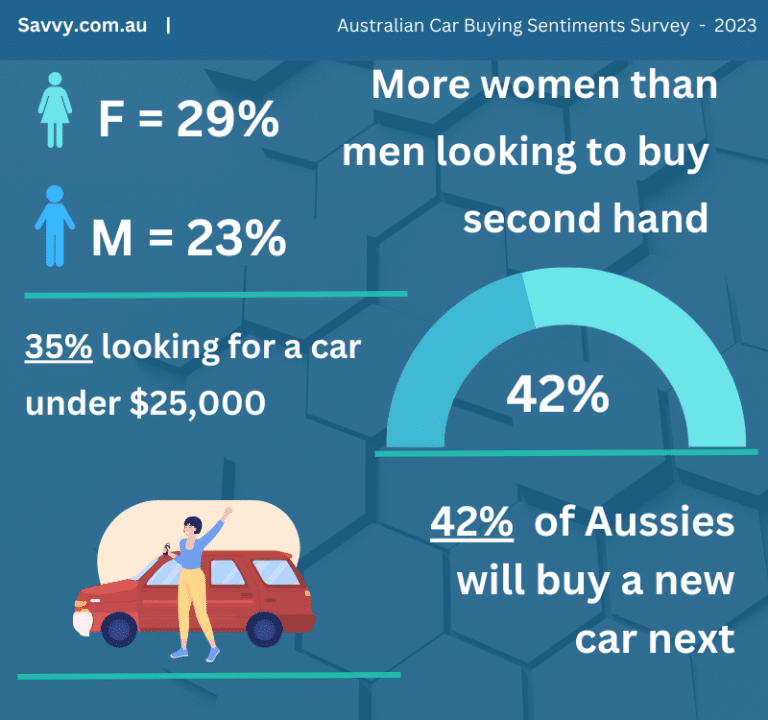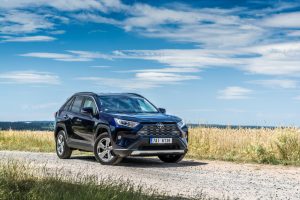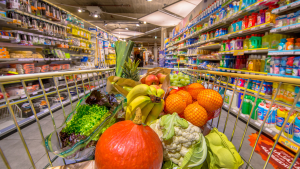
- The Savvy Promise
At Savvy, our mission is to empower you to make informed financial choices. While we maintain stringent editorial standards, this article may include mentions of products offered by our partners. Here’s how we generate income.
In this article
As part of Savvy’s ongoing research into consumer behaviour and sentiment, our latest representative survey looks at the budget and appetite for buying new vehicles.
- 42% of Australians will buy a brand-new car when shopping for their next car
- 35% of Australians are looking to buy a new car for about $25,000
- 32% will spend $26,000 – $40,000
- 29% will spend $40,000 – $80,000
- Only 4% of Australians are looking to spend over $80,000
- More women (29%) are looking to buy second hand than men (23%)
A nationally representative survey (n=1,000) conducted by Savvy into car buying sentiments has shown that 42% have their hearts set on a brand-new set of wheels over all other alternatives.
45% of men and 38% of women expressed this view, with numbers staying in the low to mid-40s among most demographics excepting the 18-24 cohort (34%).
26% of Australians will look for something second hand, while 22% will consider an ex-demo model. Only 3% of Australians will consider an ex-fleet or auction sold car.
Aussies looking for budget deals
When asked how much Australians will spend on their next car, 35% said they would spend $25,000 or less; 39% of women versus 30% of men.
With sub-$25,000 new cars in plentiful supply – even entry level four door models boasting Apple CarPlay and Android Auto integration as well as modern safety features – there’s something for bargain hunters at the inexpensive end of the new car buying spectrum.
32% reported they will spend between $26,000-$40,000, while 29% will spend between $40,000-$80,000.
Only 4% said they were prepared to spend more than $80,000.
Though many will see the $80,000 price tag as a sign of luxury, it prices many modest Electric Vehicles (EVs) out of the reach of most Australians. The popular Hyundai IONIQ 6 base model starting price of $76,000 tips the scales for most in the survey.

Savvy spokesperson Adrian Edlington says that the EV future needs to be affordable before it can become the present.
“In our previous survey, 41 percent of respondents said they’d be open to buying an EV, though 76 percent agreed that prices were too high. This is borne out in the results of this survey.
“The bulk of EVs still hover around the 70 thousand-to-80-thousand-dollar mark, placing them near the luxury car market in terms of pricing. With cost of living still high, Aussies in the market for something new will want something that’s cheap to buy, packed with features, and cheap to run. Typical fuel-efficient cars under 20 thousand dollars still fit that mould.
“It may take a few years for EVs and EV policy to catch up.”
Cheapest new car in Australia – 2023
According to our survey, Australians are clamouring for a cheap new car, preferably one with a sub-$25,000 price tag. What are the options for Aussies buying a reasonably priced or even cheap new car in 2023?
The cheapest car available in Australia as of 2023 is the third-generation Kia Picanto S, a 1.25L four-cylinder, four door hatch which is available at the base price of $18,990 drive away. It packs features such as six airbags, autonomous emergency braking, 8” infotainment centre, wireless Apple CarPlay and Android Auto, automatic headlamps, and USB/Bluetooth connectivity. This price is for the five-speed manual transmission version, with automatic being an $1,600 upgrade.
The 2023 MG 3 Core Auto is the cheapest automatic car you can buy at $19,490 drive away. A four door, 1.5L four cylinder and four-speed transmission zipper, it boasts a 6.7L/100km fuel efficiency, 8” infotainment centre, wired Apple CarPlay and Android Auto, and wireless Bluetooth connectivity, it doesn’t feature the AEB like the Picanto.
The cheapest SUV on the market at the moment is the 2023 Suzuki Ignis, powered by a 1.2L four-cylinder that ekes out 66kW and 120Nm. It is only a 2WD through a five-speed manual transmission. Suzuki claims a 4.7L/100km on a 32L fuel tank. It too has a 7” infotainment system, wired Apple CarPlay and Android Auto, Bluetooth, and cruise control. All this for $20,490 before on-road costs.
How much would you spend on your next car? – by gender
| Total | Male | Female | Other | Total | 1000 | 499 | 495 | 6 |
|---|---|---|---|---|
| $0 - $25k | 346 | 149 | 194 | 3 |
| $26 - $40k | 322 | 152 | 169 | 1 |
| $41 - $80k | 291 | 172 | 117 | 2 |
| $81 - $100k | 30 | 19 | 11 | - |
| $100k + | 11 | 7 | 4 | - |
Source: Savvy Automotive Survey 2023, n=1000
How much would you spend on your next car? – by age group
| 18 - 24 | 25 - 34 | 35 - 44 | 45 - 54 | 55 - 64 | 65+ | Total | 119 | 193 | 171 | 163 | 149 | 205 |
|---|---|---|---|---|---|---|
| $0 - $25k | 51 | 69 | 53 | 51 | 50 | 72 |
| $26 - $40k | 35 | 62 | 54 | 41 | 51 | 79 |
| $41 - $80k | 23 | 56 | 58 | 62 | 45 | 47 |
| $81 - $100k | 8 | 5 | 5 | 6 | 1 | 5 |
| $100k + | 2 | 1 | 1 | 3 | 2 | 2 |
Source: Savvy Automotive Survey 2023, n=1000
New car sales
According to the Federal Chamber of Automotive Industries (FCAI), new vehicle sales achieved their highest August result on record, as Australians bought 109,966 new vehicles, representing a 15.4% increase year on year.
Year to date sales have increased 9.9% overall.
The most popular category was SUVs, selling 62,313 units, followed by passenger cars at 19,336.
That represents 140,419 passenger vehicles and 441,529 SUVs for the year to date. The SUV market has climbed 28.3% year-over-year.
Which option best aligns with your preference for purchasing your next car? – by gender
| Total | Male | Female | Other | Total | 1000 | 499 | 495 | 6 |
|---|---|---|---|---|
| Opting for a new car directly from a dealer or manufacturer. | 416 | 227 | 186 | 3 |
| Considering an ex-demonstration vehicle from a new car dealer. | 220 | 106 | 112 | 2 |
| Exploring used cars available from a second-hand car yard or private seller. | 257 | 115 | 142 | - |
| Exploring ex-fleet vehicles from auctions or similar sources. | 26 | 12 | 14 | - |
| None of the above / I am not considering buying a car at all. | 81 | 39 | 41 | 1 |
Source: Savvy Automotive Survey 2023, n=1000
Which option best aligns with your preference for purchasing your next car? – by age group
| 18 - 24 | 25 - 34 | 35 - 44 | 45 - 54 | 55 - 64 | 65+ | Total | 119 | 193 | 171 | 163 | 149 | 205 |
|---|---|---|---|---|---|---|
| Opting for a new car directly from a dealer or manufacturer. | 40 | 81 | 75 | 68 | 60 | 92 |
| Considering an ex-demonstration vehicle from a new car dealer. | 14 | 43 | 38 | 42 | 36 | 47 |
| Exploring used cars available from a second-hand car yard or private seller. | 54 | 52 | 44 | 32 | 34 | 41 |
| Exploring ex-fleet vehicles from auctions or similar sources. | 2 | 5 | 3 | 6 | 5 | 5 |
| None of the above / I am not considering buying a car at all. | 9 | 12 | 11 | 15 | 14 | 20 |
Source: Savvy Automotive Survey 2023, n=1000
Buying a new car – statistics
According to the FCAI, Toyota was the highest selling car brand with 22,321 sales in August, followed by Mazda on 8,458, then Ford on 7,898. The Toyota HiLux was the top-selling vehicle overall at 5,762 sales. It was followed by the Ford Ranger (5,760) and the Toyota Rav4 (3,317). More than 1 in 6 vehicles sold were classed as low-emission vehicles.
Buying a second-hand car
During the government response to the COVID-19 pandemic, new car arrivals almost halted overnight due to supply chain issues, labour shortages, and border closures. Deliveries of new cars blew out from a month or two to over 12 months in some cases.
Over September 2020 to September 2021, the median price of a second-hand car jumped 23.8%. As new car supply has improved over 2023, Moody’s Analytics showed that used car prices fell 12% in December 2022 after a May 2022 peak. They have also forecasted that used car prices will fall another 10% in 2023 and stabilise in 2024. This doesn’t consider inflationary pressures and interest rate rises softening demand.
Car auctions – a possibility?
Car auctions – especially for ex-fleet or ex-government vehicles, are a popular option to get a bargain deal amid high prices. Pickles or Gray’s Online car auctions may connect you with well maintained vehicles that aren’t usually available via the usual second-hand dealer or private seller’s market. Though you can walk away with a cheaper car, it takes a bit of time and patience – as well as skill – to net yourself a car from an auction, especially if you’re a newbie.
Savvy 2024 Car Buying Sentiments Survey; n=1000
Nationally representative survey of 1000 adult Australians, aged 18 and over. Conducted by Octopus Group, on behalf of Savvy.
Completion date: 2/09/2023
Age groups:18-24, 25-34, 35-44, 45-54, 55-64, 65+
Gender breakdown: male n=499, female n=495, non-binary /prefer not to say n=6
Representative of state and territory populations:
NSW n=320 (32.3%), Vic n=252 (25.1%), Qld n=194 (20.2%), SA n=75 (7.2%), WA n=108 (10.6%) NT n=9 (0.7%), Tas n=23 (2.2%), ACT n=19 (1.7%)
Sources:
FCAI.com.au, Record Breaking New Vehicle Sales in August, 05 Sep 2023
Did you find this page helpful?
Author
Adrian EdlingtonPublished on October 10th, 2023
Last updated on June 18th, 2024
Fact checked
This guide provides general information and does not consider your individual needs, finances or objectives. We do not make any recommendation or suggestion about which product is best for you based on your specific situation and we do not compare all companies in the market, or all products offered by all companies. It’s always important to consider whether professional financial, legal or taxation advice is appropriate for you before choosing or purchasing a financial product.
The content on our website is produced by experts in the field of finance and reviewed as part of our editorial guidelines. We endeavour to keep all information across our site updated with accurate information.










